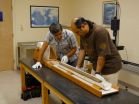(Press-News.org) The over 50s who are 'successful agers'--healthy, active, sociable, and well off--are more at risk of harmful drinking than their less successful peers, concludes research published in the online journal BMJ Open.
Harmful drinking is a "middle class phenomenon" which may be a hidden health and social problem in otherwise successful older people, warn the researchers, who call for explicit guidelines on alcohol consumption for this group.
They base their findings on more than 9000 responses to the two most recent waves (2008-9 and 2010-11) of the English Longitudinal Survey of Ageing (ELSA)--a long term study of a representative sample of those aged 50 and above living independently at home in England.
Given that alcohol consumption is on the rise among older people in England, the researchers wanted to tease out the social and economic factors associated with harmful drinking, and changing patterns of consumption over time.
They used national guidance to define increasing risk of harmful drinking at 22-50 weekly units for men and 15 to 35 weekly units for women; and higher risk, at more than 50 and more than 35 weekly units, respectively, for men and women.
Survey participants were asked about a range of potentially influential factors: income; educational attainment; self reported health; whether they smoked; diet; physical activity levels; whether they felt lonely or depressed; ethnic background; marital status; caring responsibilities; religious beliefs; employment status; and social engagement (civic participation, networks of friends, cultural activities).
Analysis of the responses showed that the risk of harmful drinking peaked for men in their early 60s and then gradually tailed off, whereas for women risky drinking fell in tandem with age.
These patterns suggest that the current group of over 50s may be carrying on levels of higher consumption developed in their younger years, in later life, say the researchers.
Certain factors were linked to a heightened or lowered risk of harmful drinking.
Income was associated with a higher risk, but only among women, while smoking, higher educational attainment, and good health were all linked to heightened risk in both sexes.
Higher risk of harmful drinking was not linked to feelings of loneliness or depression, but it was more likely among men living on their own, including those who were separated/divorced. And it was more common among men of white ethnicity.
Caring responsibilities lowered the probability of being at higher risk among women, but religious belief did not--for either sex.
Employment status did not seem to be a significant factor, but women who had retired were more likely to be at higher risk.
When the researchers looked at changes in alcohol consumption between the two waves of the survey, they found that among women, loneliness, younger age, and higher income were all associated with the likelihood of becoming a higher risk drinker by 2010-11. A healthy diet seemed to lessen the risk.
Among men, these transition patterns were similar, except that caring responsibilities, loneliness, older age and lower income increased the likelihood of no longer drinking at risky levels by wave 2 of the survey.
"We can sketch--at the risk of much simplification--the problem of harmful drinking among people aged 50 or over in England as a middle class phenomenon: people in better health, higher income, with higher educational attainment and socially more active are more likely to drink at harmful levels," write the researchers.
"Our findings suggest that harmful drinking in later life is more prevalent among people who exhibit a lifestyle associated with affluence and with a 'successful' ageing process," they add.
"Harmful drinking may then be a hidden health and social problem in otherwise successful older people," they warn, concluding: "Consequently, and based on our results, we recommend the explicit incorporation of alcohol drinking levels and patterns into the successful ageing paradigm."
INFORMATION:
Two new studies, both published in The Lancet, suggest that two different classes of drugs, aromatase inhibitors (AIs) and bisphosphonates, can each improve survival prospects for postmenopausal women with early breast cancer. Moreover, the researchers suggest that the two types of drug can be used together, increasing the benefits while also decreasing some side-effects.
Most women are post-menopausal when they develop breast cancer, and breast cancer is usually found early, when surgery can remove all detectable disease, but might leave dangerous undetected micrometastases ...
A class of hormonal drugs called aromatase inhibitors substantially reduce the risk of death in postmenopausal women with the most common type of breast cancer, a major study of more than 30,000 women shows.
The research underlines the importance of aromatase inhibitors in the treatment of oestrogen receptor (ER)-positive breast cancer - and shows they reduce risk of death by significantly more than the older hormonal treatment tamoxifen.
The study, published in The Lancet today (Friday), is relevant to postmenopausal women with ER-positive breast cancer, which accounts ...
Highlight
Proteins in the Wnt signaling pathway help drive kidney scarring that can lead to chronic kidney disease.
Washington, DC (July 23, 2015) -- Chronic diseases such as diabetes and hypertension cause injury to the kidneys, which can lead to scarring and the development of chronic kidney disease. By identifying proteins important to this scarring process, researchers now point to a new strategy for possibly preventing kidney failure and the need for dialysis or transplantation in many patients. The findings appear in an upcoming issue of the Journal of the ...
MIAMI - New research reveals that some of the earliest civilizations in the Middle East and the Fertile Crescent may have been affected by abrupt climate change. These findings show that while socio-economic factors were traditionally considered to shape ancient human societies in this region, the influence of abrupt climate change should not be underestimated.
A team of international scientists led by researchers from the University of Miami (UM) Rosenstiel School of Marine and Atmospheric Science found that during the first half of the last interglacial period known ...
A biomarker found in the blood of alcohol users is significantly higher in binge drinkers than in those who consume alcohol moderately, according to a study by researchers at the University of Illinois at Chicago. The biomarker, called phosphatidylethanol (PEth), could be used to screen young adults for harmful or heavy drinking such as binge drinking.
Having performed extensive research on alcohol and its effects on health throughout her career, Mariann Piano, professor and head of the department of biobehavioral health science in the UIC College of Nursing, knew PEth ...
With the flick of a tiny mechanical wrist, a team of engineers and doctors at Vanderbilt University's Medical Engineering and Discovery Laboratory hope to give needlescopic surgery a whole new degree of dexterity.
Needlescopic surgery, which uses surgical instruments shrunk to the diameter of a sewing needle, is the ultimate form of minimally invasive surgery. The needle-sized incisions it requires are so small that they can be sealed with surgical tape and usually heal without leaving a scar.
Although it's been around since the 1990s, the technique, which is also called ...
NEW YORK, NY (July 23, 2015)--Researchers at Columbia University Medical Center (CUMC) have developed a computer algorithm that is helping scientists see how drugs produce pharmacological effects inside the body. The study, published in the journal Cell, could help researchers create drugs that are more efficient and less prone to side effects, suggest ways to regulate a drug's activity, and identify novel therapeutic uses for new and existing compounds.
"For the first time we can perform a genome-wide search to identify the entire set of proteins that play a role in ...
SPOKANE, Wash. - Pharmaceutical sciences researchers at Washington State University have discovered a protein's previously unknown role in cell division.
The well known protein ATF5, or Activating Transcription Factor 5, controls how often specific genes are expressed, or copied from DNA. ATF5 regulates genes that control cell survival.
But the research team has identified a part this protein is playing that is not related to its transcription factor role. Within the part of the cell called the centrosome, ATF5 is also acting as a structural protein.
Structural ...
Knee pain in older adults, often caused by osteoarthritis, usually means more visits to the doctor and also can be a harbinger of disability.
A study led by Daniel White, assistant professor of physical therapy at the University of Delaware, found that an intensive regimen of regular exercise and a healthy diet might reduce the short-term onset of knee pain for overweight adults with Type 2 diabetes mellitus.
Published in Arthritis Care and Research, White's article "Can an Intensive Diet and Exercise Program Prevent Knee Pain Among Overweight Adults at High Risk'' ...
New research has revealed abrupt warming, that closely resembles the rapid man-made warming occurring today, has repeatedly played a key role in mass extinction events of large animals, the megafauna, in Earth's past.
Using advances in analysing ancient DNA, radiocarbon dating and other geologic records an international team led by researchers from the University of Adelaide and the University of New South Wales (Australia) have revealed that short, rapid warming events, known as interstadials, recorded during the last ice age or Pleistocene (60,000-12,000 years ago) ...



